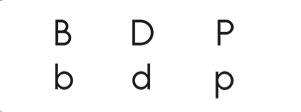If you work with beginning or developing readers, chances are you’ve encountered a student who has difficulty identifying certain lowercase letters. While uppercase letters are more easily distinguished, lowercase letters like b, d, p, and q—which look very similar—tend to cause confusion.
As you know, a student who has not yet mastered all the letters is less able to quickly and accurately decode words and might also write them incorrectly. For example, the student might incorrectly read or write big for the word pig or dig. Letter confusion adds an extra challenge to the already difficult tasks of learning to read and write.
Thankfully, our educational consultant, Karen Hunter, has shared a simple strategy to help students master visually confusing letters and avoid reversing, rotating, or inverting them in reading and writing.
According to Karen, an effective way to offer support and hold a student accountable for accuracy is to provide a cue card that displays pairs of uppercase and lowercase letters. The cue card would look like the example below, which shows b, d, and p along with their uppercase counterparts.

The teacher provides the student with the cue card and directs him or her to refer to the card whenever s/he reads or writes a word with a confusing lowercase letter. The student confirms a lowercase letter on the bottom of the cue card by checking it against its more distinguishable uppercase form on the top. According to Karen, “by confirming the identity of the lowercase letter with its uppercase counterpart over and over again, the student moves toward mastery.”
Karen designed free cue card templates (including sample cue cards for the letters b, d, and p), which are available on the Read Naturally website. Feel free to use these templates to create custom cue cards and then print them on sheets of self-stick labels or on card stock that can be cut apart. You can also create individualized cue cards with Post-it® Notes for the specific letters that a student tends to confuse.
Cue cards are an effective strategy to support beginning and developing readers by helping them master their letters. Thank you, Karen, for providing this excellent free resource!
Click here to download the Free Cue Card Template and b-d-p Example
 Share your student’s success story—nominate him or her for our Star of the Month award. Win a Barnes & Noble gift card for the student and a Read Naturally gift certificate for your class!
Share your student’s success story—nominate him or her for our Star of the Month award. Win a Barnes & Noble gift card for the student and a Read Naturally gift certificate for your class!
Using finger spelling can also help students with visually confusing letters. Make the sign for "b" and it looks like a lowercase b formed with your palm and curved thumb. Make the sign for "d" and it looks like a lowercase d. I've taught children as well as adults and found that using finger spelling can be a great teaching strategy.